Satas D., Tracton A.A. (ed.). Coatings Technology Handbook
Подождите немного. Документ загружается.

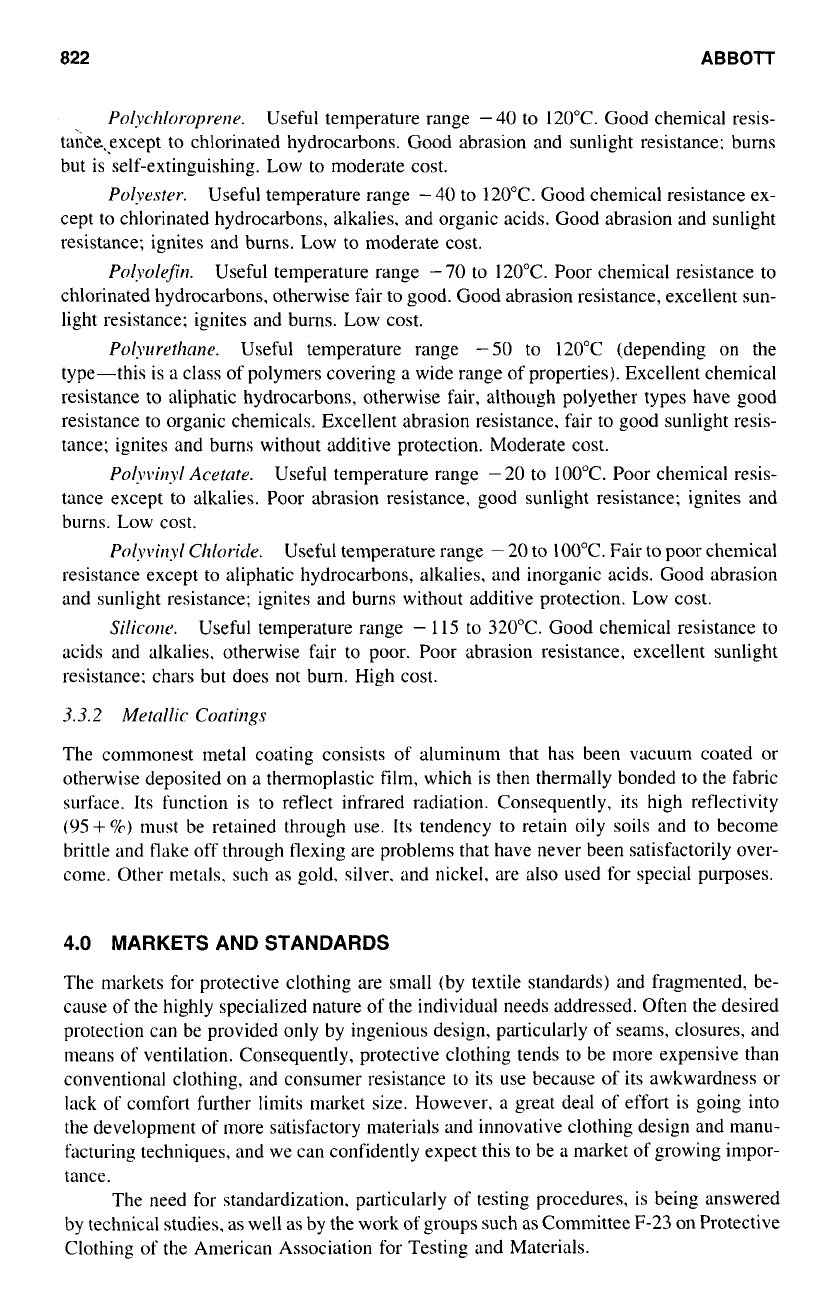
822
ABBOTT
Po/ych/nroprer~e.
Useful temperature range
-
40
to
120°C. Good chemical resis-
tahce.except to chlorinated hydrocarbons. Good abrasion and sunlight resistance; burns
but is self-extinguishing. Low
to
moderate cost.
Polyester.
Useful temperature range
-40
to 120°C. Good chemical resistance ex-
cept to chlorinated hydrocarbons, alkalies, and organic acids. Good abrasion and sunlight
resistance; ignites and burns. Low to moderate cost.
Po/yo/efin.
Useful temperature range
-
70 to 120°C. Poor chemical resistance to
chlorinated hydrocarbons, otherwise fair to good. Good abrasion resistance, excellent sun-
light resistance: ignites and burns. Low cost.
Pdyurethnne.
Useful temperature range -50
to
120°C (depending on the
type-this is a class of polymers covering a wide range of properties). Excellent chemical
resistance to aliphatic hydrocarbons, otherwise fair, although polyether types have good
resistance to organic chemicals. Excellent abrasion resistance. fair to good sunlight resis-
tance; ignites and burns without additive protection. Moderate cost.
Po/winy/ Acetote.
Useful temperature range
-
20 to 100°C. Poor chemical resis-
tance except to alkalies. Poor abrasion resistance, good sunlight resistance; ignites and
burns. Low cost.
Polyvirlyl Chloride.
Useful temperature range
-
20 to 100°C. Fair to poor chemical
resistance except to aliphatic hydrocarbons, alkalies, and inorganic acids. Good abrasion
and sunlight resistance; ignites and burns without additive protection. Low cost.
Si/icone.
Useful temperature range
-
115
to 320°C. Good chemical resistance to
acids and alkalies, otherwise fair to poor. Poor abrasion resistance, excellent sunlight
resistance; chars but does not burn. High cost.
3.3.2
Metallic Coatirtgs
The commonest metal coating consists
of
aluminum that has been vacuum coated or
otherwise deposited
on
a thermoplastic film, which is then thermally bonded to the fabric
surface. Its function is to reflect infrared radiation. Consequently, its high reflectivity
(95
+?h)
tnust be retained through use. Its tendency
to
retain oily soils and
to
become
brittle and flake off through tlexing are problems that have never been satisfactorily over-
come. Other metals, such as gold. silver, and nickel, are
also
used for special purposes.
4.0
MARKETS AND STANDARDS
The markets for protective clothing are small (by textile standards) and fragmented, be-
cause of the highly specialized nature
of
the individual needs addressed. Often the desired
protection can be provided only by ingenious design, particularly of seams, closures, and
means of ventilation. Consequently, protective clothing tends to be more expensive than
conventional clothing, and consumer resistance
to
its use because
of
its awkwardness or
lack of comfort further limits market size. However, a great deal of effort is going into
the development of more satisfactory materials and innovative clothing design and manu-
facturing techniques, and we can confidently expect this to be a market of growing impor-
tance.
The need for standardization, particularly of testing procedures, is being answered
by technical studies.
as
well
as
by the work of groups such as Committee F-23 on Protective
Clothing of the American Association for Testing and Materials.
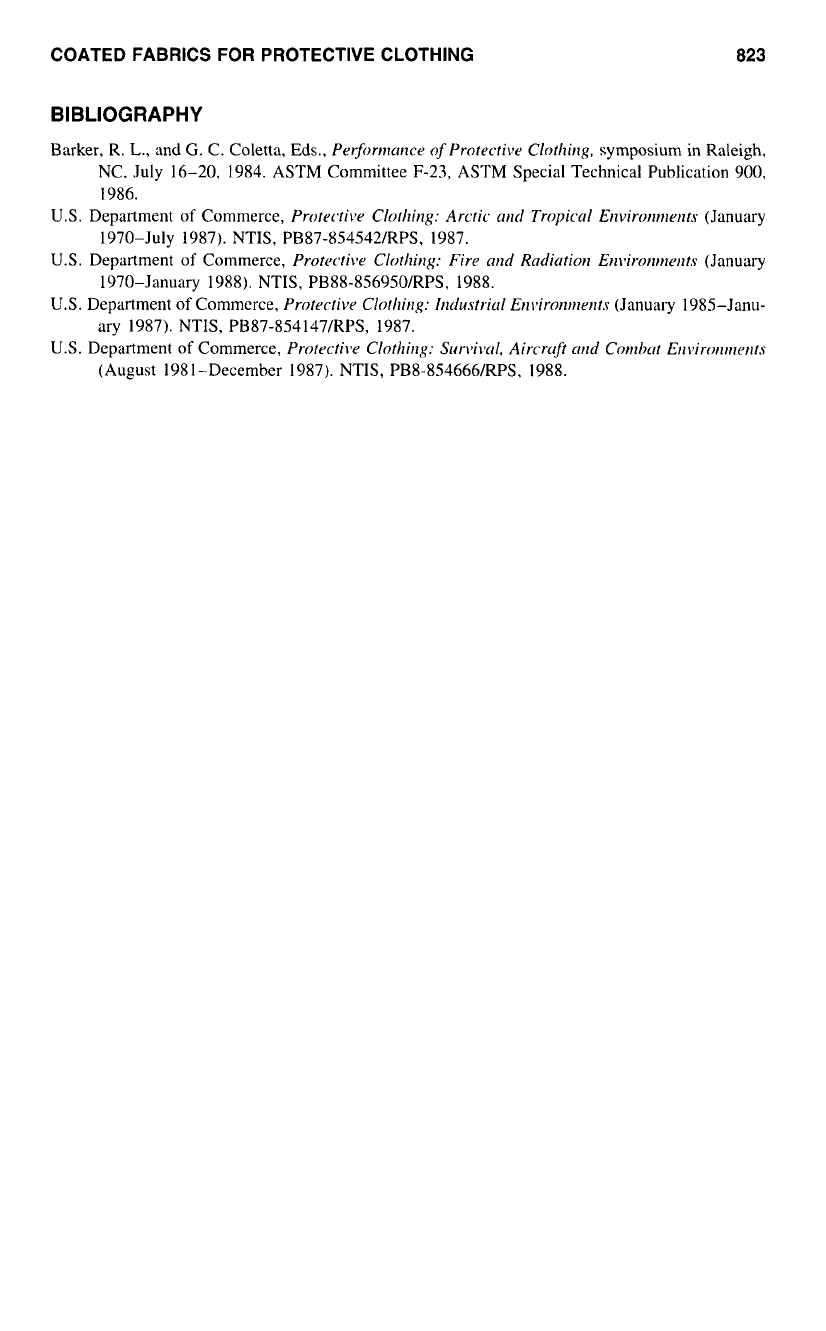
COATED FABRICS FOR PROTECTIVE CLOTHING
823
BIBLIOGRAPHY
Barker, R.
L.,
and
G.
C. Coletta, Eds.,
Perforrllcrnce
ofProtective
Clothing.
symposium
in
Raleigh,
NC. July 16-20, 1984. ASTM Committee
F-23,
ASTM Special Technical Publication 900,
1986.
U.S.
Department
of
Commerce,
Protectirv
Clothing:
Arctic
ctrd
Tropicnl
Envirorrnrents
(January
U.S.
Department
of
Commerce,
Protectilv
Clothirlg:
Fire
md
Rndirrtiorl
Enviror~rnc~rrt.~
(January
U.S.
Department
of
Commerce,
Proterriw
Clo/hitlg:
Ir~dustrictl
Envirorznrer~t.~
(January 1985-Janu-
U.S.
Department
of
Commerce,
Protective
Clothing:
Srtrvivctl.
AircrcrJt
nr1d
Con~hrrt
~/~~~ir~~~~~?rc,~~t.~
1970-July 1987). NTIS, PB87-854542/RPS, 1987.
1970-January 1988). NTIS, PB88-856950/RPS, 1988.
ary 1987). NTIS, PB87-854147/RPS, 1987.
(August 1981-December 1987). NTIS, PB8-854666/RPS, 1988.
This Page Intentionally Left Blank
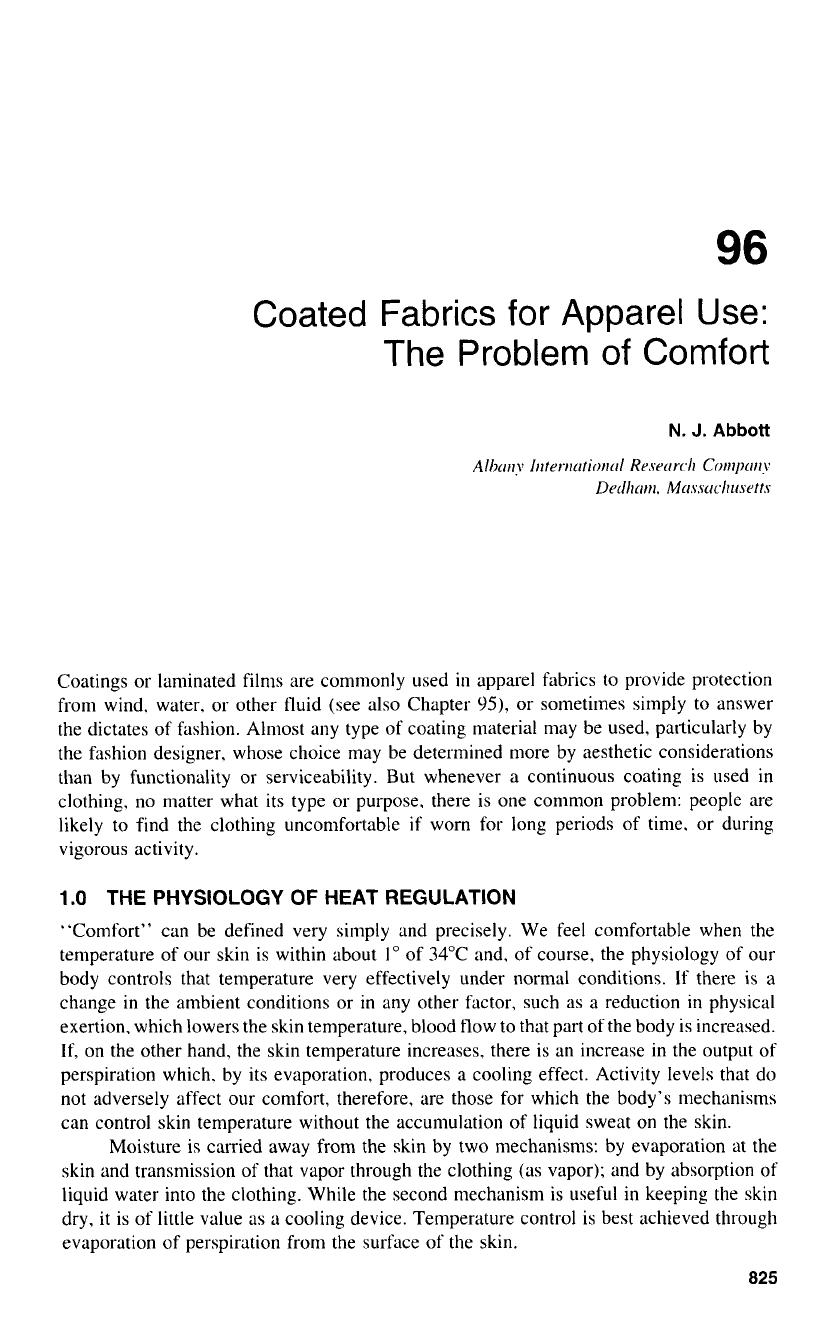
96
Coated Fabrics for Apparel Use:
The Problem
of
Comfort
Coatings or laminated films are commonly used
in
apparel fabrics
to
provide protection
from wind. water, or other fluid (see also Chapter
M),
or sometimes simply
to
answer
the dictates
of
fashion. Almost any type of coating material may be used. particularly by
the fashion designer. whose choice may be determined more by aesthetic considerations
than by functionality or serviceability. But whenever a continuous coating is used in
clothing, no matter what its type or purpose. there is one common problem: people are
likely
to
find the clothing uncomfortable
if
worn for long periods
of
time. or during
vigorous activity.
1.0
THE PHYSIOLOGY
OF
HEAT REGULATION
“Comfort” can be defined very simply and precisely. We feel comfortable when the
temperature of our skin is within about
1”
of
34°C and.
of
course, the physiology of our
body controls that temperature very effectively under normal conditions. If there is a
change
in
the ambient conditions or
in
any other factor, such as a reduction
in
physical
exertion. which lowers the skin temperature, blood flow
to
that part
of
the body is increased.
If,
on the other hand, the skin temperature increases, there is an increase in the output
of
perspiration which. by its evaporation, produces a cooling effect. Activity levels that do
not adversely affect our comfort, therefore, are those for which the body’s mechanisms
can control skin temperature without the accumulation
of
liquid sweat
on
the skin.
Moisture is carried away from the skin by two mechanisms: by evaporation at the
skin and transmission
of
that vapor through the clothing (as vapor); and by absorption of
liquid water into the clothing. While the second mechanism is useful in keeping the skin
dry, it is of little value as a cooling device. Temperature control
is
best achieved through
evaporation of perspiration from the surface of the skin.
825
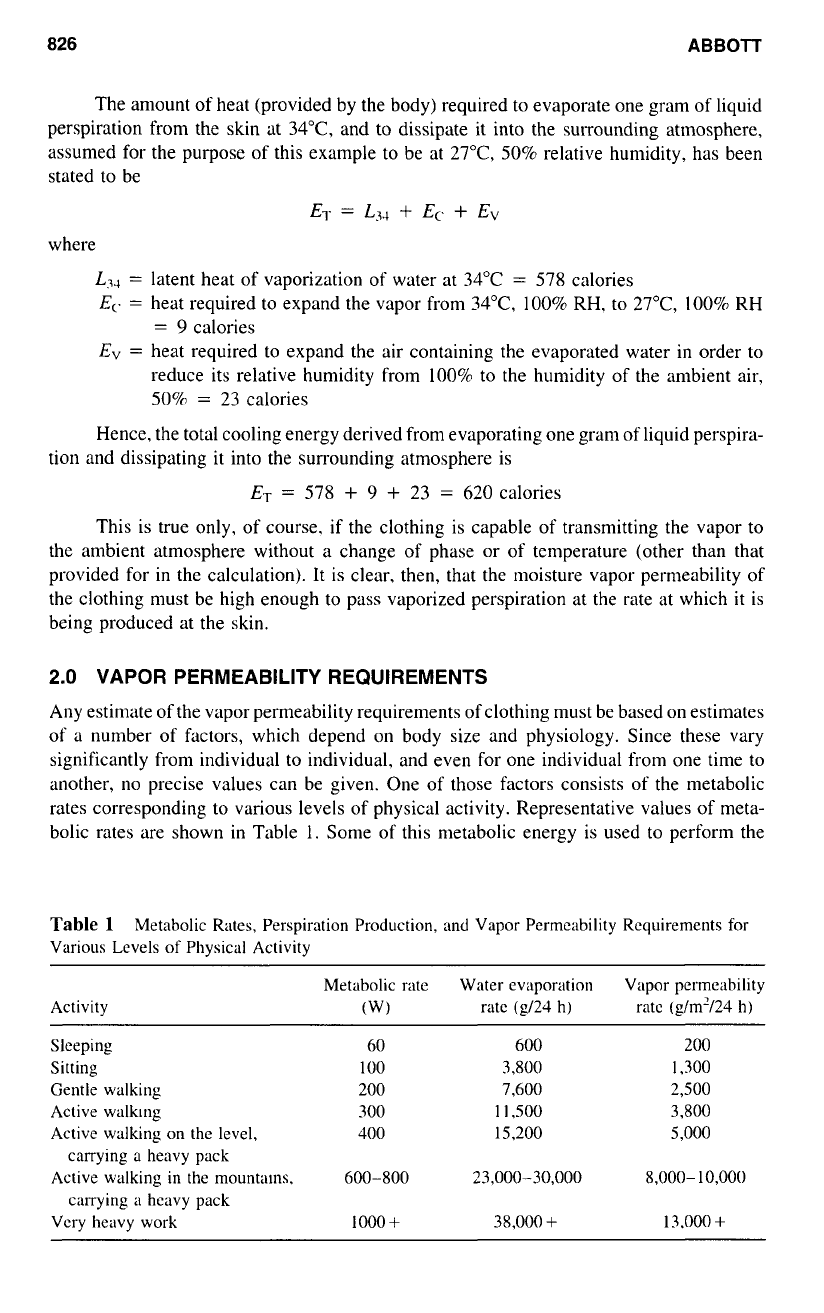
826
ABBOTT
The amount of heat (provided by the body) required
to
evaporate one gram of liquid
perspiration from the skin at
34"C,
and to dissipate it into the surrounding atmosphere,
assumed for the purpose of this example to be at
27"C,
50%
relative humidity, has been
stated to be
ET
=
L34
+
EC
+
Ev
where
L34
=
latent heat of vaporization of water at
34°C
=
578
calories
Ec.
=
heat required to expand the vapor from
34"C,
100%
RH,
to
27"C,
100%
RH
Ev
=
heat required to expand the air containing the evaporated water in order to
reduce its relative humidity from
100%
to
the humidity of the ambient air,
50%
=
23
calories
=
9
calories
Hence, the total cooling energy derived from evaporating one gram
of
liquid perspira-
tion and dissipating it into the surrounding atmosphere is
ET
=
578
+
9
+
23
=
620
calories
This is true only, of course. if the clothing is capable
of
transmitting the vapor to
the ambient atmosphere without a change
of
phase or
of
temperature (other than that
provided for in the calculation). It is clear, then, that the moisture vapor permeability of
the clothing must be high enough to pass vaporized perspiration at the rate at which
it
is
being produced at the skin.
2.0
VAPOR PERMEABILITY REQUIREMENTS
Any estimate of the vapor permeability requirements
of
clothing must be based on estimates
of
a number
of
factors, which depend on body size and physiology. Since these vary
significantly from individual
to
individual, and even for one individual from one time to
another, no precise values can be given. One of those factors consists of the metabolic
rates corresponding to various levels of physical activity. Representative values
of
meta-
bolic rates are shown
in
Table
l.
Some of this metabolic energy is used
to
perform the
Table
1
Metabolic Rates, Perspiration Production,
and
Vapor Permeability Requirements for
Various
Levels
of Physical Activity
Activity
Metabolic ratc Water evaporation Vapor permeability
(W) ratc
(g124
h) ratc (g/m'/24 h)
Sleeping
60 600 200
Sitting
100 3,800 1,300
Gentle walking
200 7,600 2,500
Active walklng
300
1
1.s00 3,800
Active walking on the level,
400 15,200
S
,000
Active walking in the mountains.
600-X00
23,000-30,000
8,000- 10,000
Very heavy work
1000
+
38,000
+
13.000
+
carrying a heavy pack
carrying
a
hcavy pack
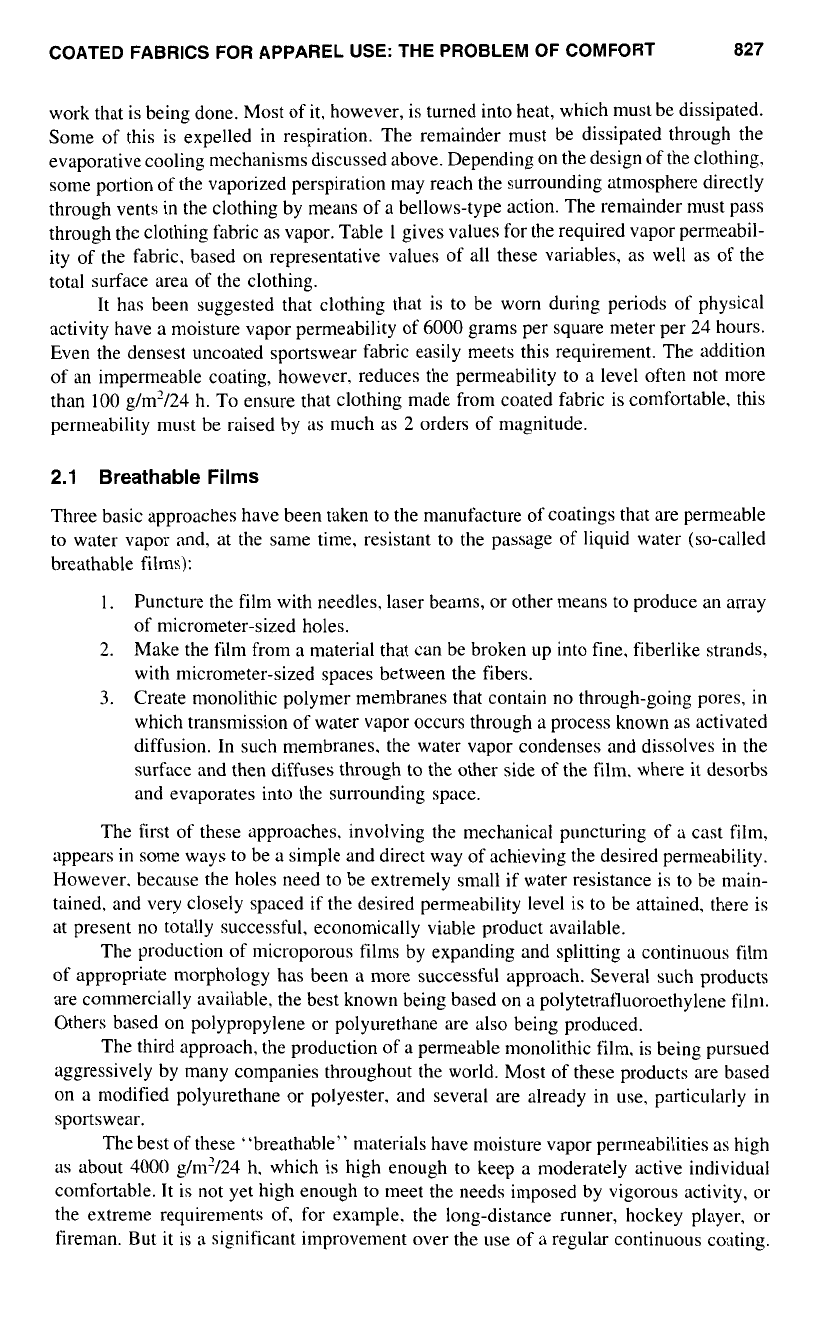
COATED FABRICS
FOR
APPAREL USE: THE PROBLEM OF COMFORT
827
work that is being done. Most of it, however, is turned into heat, which must be dissipated.
Some
of
this is expelled in respiration. The remainder must be dissipated through the
evaporative cooling nlechanisms discussed above. Depending on the design of the clothing.
some portion of the vaporized perspiration may reach the surrounding atmosphere directly
through vents
in
the clothing by means of a bellows-type action. The remainder must pass
through the clothing fabric as vapor. Table
1
gives values for the required vapor permeabil-
ity of the fabric, based on representative values of all these variables, as well as
of
the
total surface area of the clothing.
It has been suggested that clothing that is
to
be worn during periods of physical
activity have a moisture vapor permeability of 6000 grams per square meter per
24
hours.
Even the densest uncoated sportswear fabric easily meets this requirement. The addition
of an impermeable coating, however. reduces the permeability to a level often not more
than 100 g/m’/24 h. To ensure that clothing made from coated fabric is comfortable, this
permeability must be raised by
as
much as
2
orders of magnitude.
2.1
Breathable
Films
Three basic approaches have been taken to the manufacture of coatings that are permeable
to water vapor and, at the same time, resistant to the passage of liquid water (so-called
breathable films):
1.
Puncture the film with needles, laser beams, or other means to produce an array
of micrometer-sized holes.
2.
Make the film from a material that can be broken up into fine, fiberlike strands,
with micrometer-sized spaces between the fibers.
3.
Create monolithic polymer membranes that contain no through-going pores, in
which transmission
of
water vapor occurs through a process known as activated
diffusion. In such membranes. the water vapor condenses and dissolves
in
the
surface and then diffuses through to the other side
of
the film. where it desorbs
and evaporates into the surrounding space.
The first of these approaches. involving the mechanical puncturing
of
a cast film,
appears in some ways to be a simple and direct way of achieving the desired permeability.
However. because the holes need to be extremely small
if
water resistance is to be main-
tained, and very closely spaced
if
the desired permeability level is to be attained. there is
at present no totally successful, economically viable product available.
The production
of
microporous films by expanding and splitting a continuous film
of appropriate morphology has been a more successful approach. Several such products
are commercially available. the best known being based on a polytetrafluoroethylene film.
Others based
on
polypropylene
or
polyurethane are also being produced.
The third approach, the production of a permeable monolithic film. is being pursued
aggressively by many companies throughout the world. Most of these products are based
on a modified polyurethane or polyester. and several are already in use, particularly in
sportswear.
The best of these “breathable” materials have moisture vapor permeabilities as high
as about 4000 g/m’/24 h. which is high enough
to
keep a moderately active individual
comfortable.
It
is not yet high enough to meet the needs imposed by vigorous activity, or
the extreme requirements of. for example. the long-distance runner, hockey player, or
fireman. But
it
is
a
significant improvement over the use of a regular continuous coating.
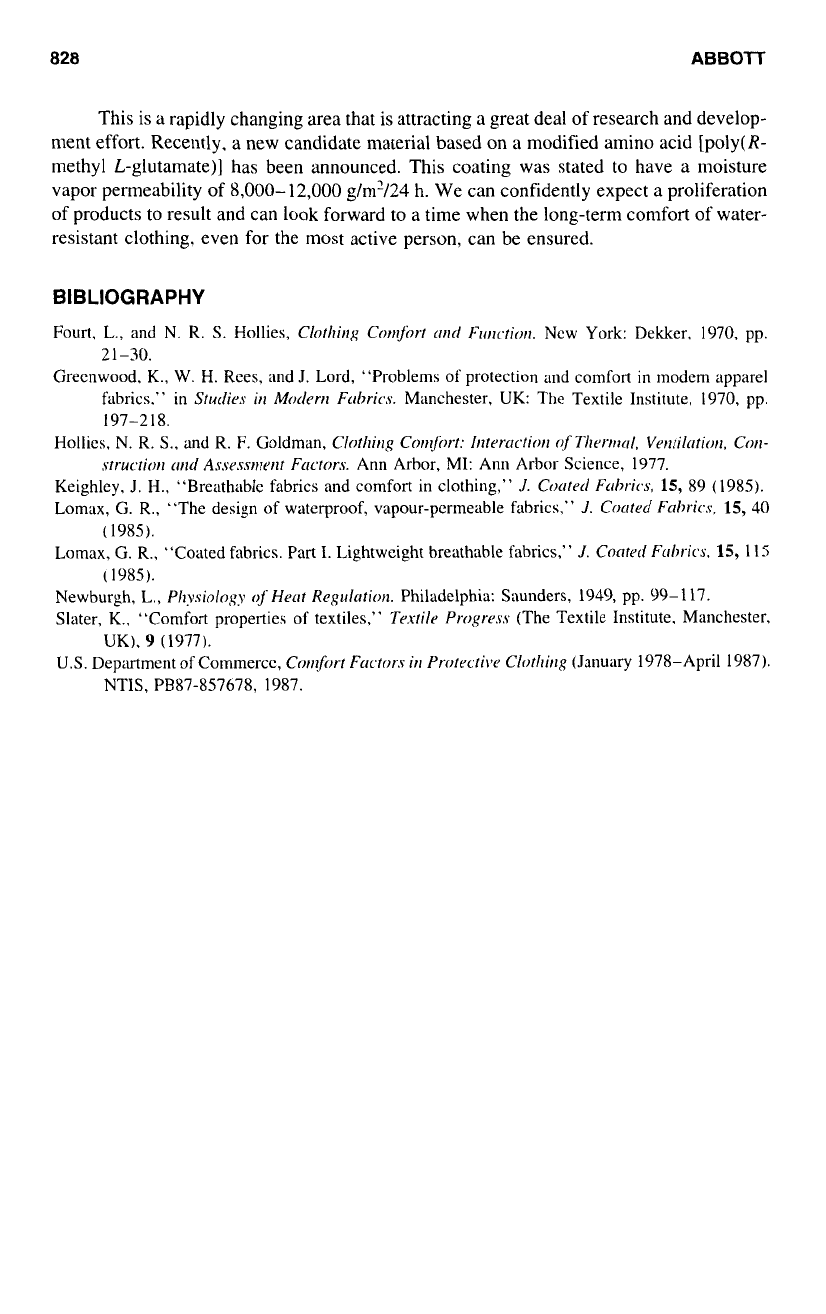
828 ABBOTT
This is a rapidly changing area that is attracting
a
great deal of research and develop-
ment effort. Recently. a new candidate material based on
a
modified amino acid [poly(R-
methyl L-glutamate)] has been announced. This coating was stated to have a moisture
vapor permeability
of
8,000-
12,000
g/m’/24
h.
We can confidently expect
a
proliferation
of products to result and can look forward to a time when the long-term comfort of water-
resistant clothing. even for the most active person, can be ensured.
BIBLIOGRAPHY
Fourt. L., and N.
R.
S.
Hollies,
Clothing
Corrfort
trrrd
Rrrrcriorr.
New
York:
Dekker. 1970, pp.
21-30.
Greenwood.
K.,
W.
H. Rces, and J. Lord, “Problems of protection and comfort in modern apparel
fabrics.” in
Sfrdies
irr
Modern
Frtbri~.~.
Manchester, UK: The Textile Institute, 1970,
pp.
Hollies, N. R.
S.,
and R. F. Goldman,
Clotlrirrg
Cornjiwt:
hrermhm
of
Tlrert~rrrl,
Ventilcrtiotr.
Corr-
Keighley.
J.
H.,
“Breathable fabrics and comfort in clothing,”
J.
Cocrterl
Ftrhri~s,
15,
89 (1985).
Lomax, G.
R.,
“The design of waterproof, vapour-permeable fabrics.”
J.
Cocrted
Fnhrics,
15,
40
Lomax, G.
R.,
“Coated fabrics. Part
I.
Lightweight breathable fabrics,”
J.
Conred
Frrhrics.
15,
115
Newburgh,
L.,
Phvsiologp
of
Herrt
Regulcrrion.
Philadelphia: Saunders, 1949, pp. 99-1 17.
Slater,
K.,
“Comfort properties
of
textiles,”
Textile
Progress
(The Textile Institute, Manchester,
U.S.
Department
of
Commerce,
Comfort
F~rctors
irr
Protectiw
Clothirrg
(January 1978-April 1987).
197-218.
srrucriorr
trrd
A.s.sessnrrnf
Frtcfors.
Ann
Arbor,
MI: Ann Arbor Science, 1977.
(
1985).
(
1985).
UK),
9
(1977).
NTIS, PB87-857678, 1987.
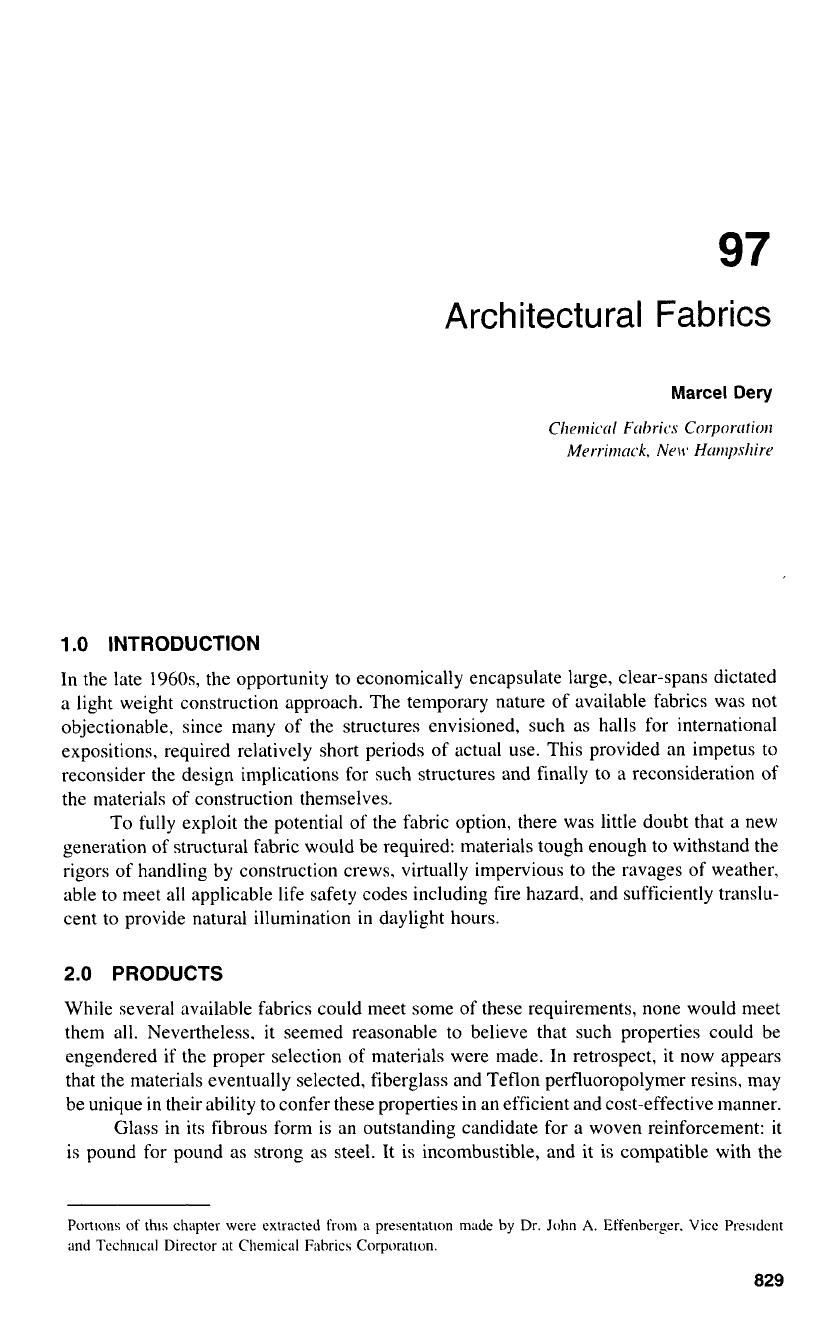
97
Architectural Fabrics
1
.O
INTRODUCTION
In the late
1960s,
the opportunity to economically encapsulate large, clear-spans dictated
a light weight construction approach. The temporary nature of available fabrics was not
objectionable, since many of the structures envisioned, such as halls for international
expositions, required relatively short periods of actual use. This provided an impetus
to
reconsider the design implications for such structures and finally to a reconsideration
of
the materials
of
construction themselves.
To
fully
exploit the potential of the fabric option, there was little doubt that a new
generation
of
structural fabric would be required: materials tough enough to withstand the
rigors of handling by construction crews. virtually impervious to the ravages of weather,
able to meet all applicable life safety codes including fire hazard. and sufficiently translu-
cent to provide natural illumination
in
daylight hours.
2.0
PRODUCTS
While several available fabrics could meet some of these requirements, none would meet
them all. Nevertheless.
it
seemed reasonable to believe that such properties could be
engendered if the proper selection
of
materials were made. In retrospect,
it
now appears
that the materials eventually selected, fiberglass and Teflon perfluoropolymer resins, may
be unique
in
their ability to confer these properties in an efficient and cost-effective manner.
Glass in its fibrous form is an outstanding candidate for a woven reinforcement:
it
is pound for pound as strong
as
steel. It is incombustible, and it is compatible with the
Portlolls
of
thts chapter were extracted
from
a
presentatton made
by
Dr.
John
A.
Effenberger.
Vice
Presldcnt
and
Techn~cal
Director
at
Chemical
Fabrics Corporation.
829
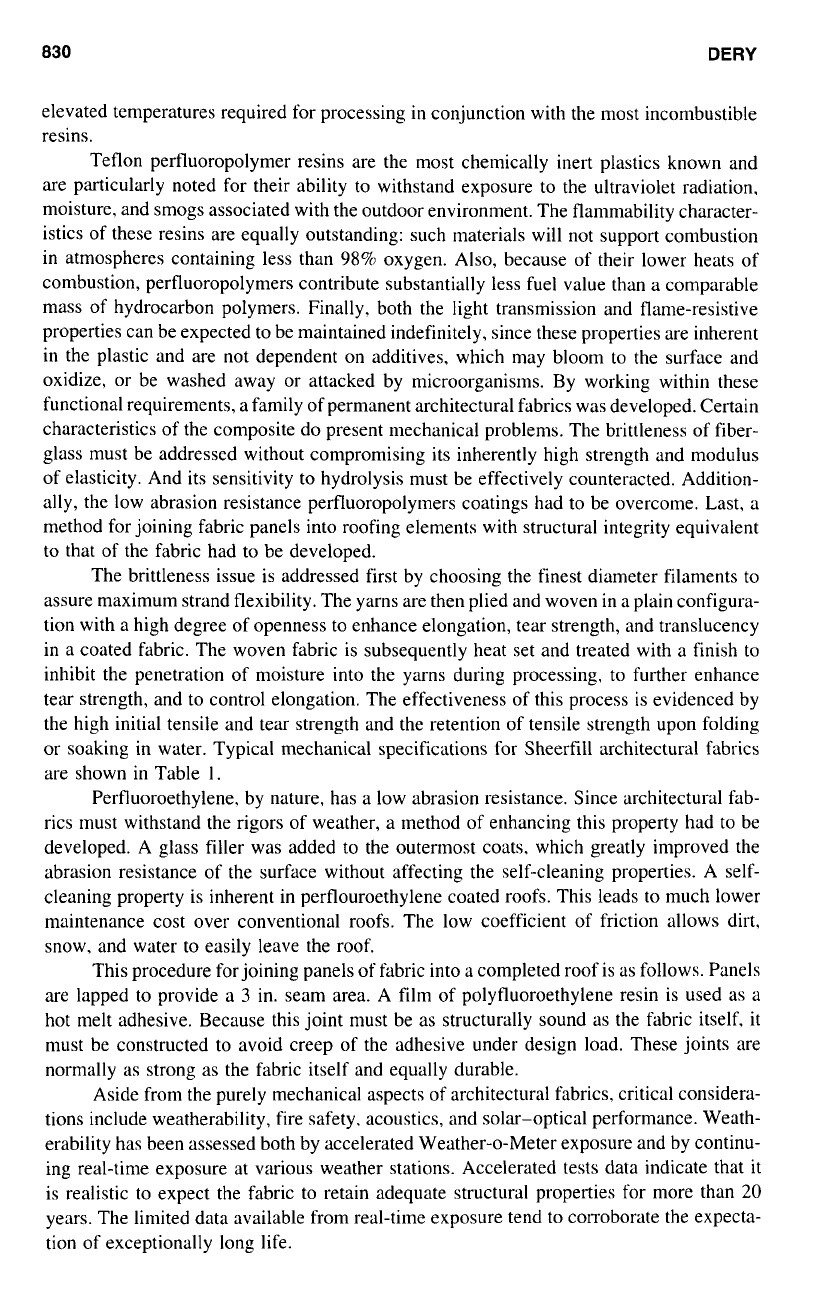
830
DERY
elevated temperatures required for processing in conjunction with the most incombustible
resins.
Teflon perfluoropolymer resins are the most chemically inert plastics known and
are particularly noted for their ability
to
withstand exposure to the ultraviolet radiation.
moisture, and smogs associated with the outdoor environment. The flammability character-
istics of these resins are equally outstanding: such materials will not support combustion
in atmospheres containing less than
98%
oxygen. Also, because of their lower heats of
combustion, perfluoropolymers contribute substantially less fuel value than a comparable
mass
of
hydrocarbon polymers. Finally. both the light transmission and flame-resistive
properties can be expected
to
be maintained indefinitely, since these properties are inherent
in the plastic and are not dependent on additives, which may bloom to the surface and
oxidize, or be washed away or attacked by microorganisms. By working within these
functional requirements,
a
family of permanent architectural fabrics was developed. Certain
characteristics of the composite do present mechanical problems. The brittleness of fiber-
glass
must
be addressed without compromising its inherently high strength and modulus
of elasticity. And its sensitivity
to
hydrolysis must be effectively counteracted. Addition-
ally, the low abrasion resistance perfluoropolyrners coatings had
to
be overcome. Last, a
method for joining fabric panels into roofing elements with structural integrity equivalent
to
that of the fabric had
to
be developed.
The brittleness issue is addressed first by choosing the finest diameter filaments
to
assure maximum strand flexibility. The yarns are then plied and woven in a plain configura-
tion with a high degree of openness
to
enhance elongation, tear strength, and translucency
in a coated fabric. The woven fabric is subsequently heat set and treated with a finish to
inhibit the penetration of moisture into the yarns during processing, to further enhance
tear strength, and to control elongation. The effectiveness of this process is evidenced by
the high initial tensile and tear strength and the retention of tensile strength upon folding
or
soaking in water. Typical mechanical specifications for Sheerfill architectural fabrics
are shown
in
Table
1.
Perfluoroethylene. by nature, has a low abrasion resistance. Since architectural fab-
rics must withstand the rigors of weather, a method of enhancing this property had
to
be
developed. A glass filler was added to the outermost coats. which greatly improved the
abrasion resistance of the surface without affecting the self-cleaning properties. A self-
cleaning property is inherent in perflouroethylene coated roofs. This leads
to
much lower
maintenance cost over conventional roofs. The low coefficient
of
friction allows dirt,
snow, and water
to
easily leave the roof.
This procedure for joining panels
of
fabric into a completed roof is as follows. Panels
are lapped
to
provide
a
3
in. seam area. A film
of
polyfluoroethylene resin is used as a
hot melt adhesive. Because this joint must be as structurally sound as the fabric itself, it
must be constructed
to
avoid creep of the adhesive under design load. These joints are
normally as strong as the fabric itself and equally durable.
Aside from the purely mechanical aspects of architectural fabrics, critical considera-
tions include weatherability, fire safety. acoustics, and solar-optical performance. Weath-
erability has been assessed both by accelerated Weather-o-Meter exposure and by continu-
ing real-time exposure at various weather stations. Accelerated tests data indicate that it
is realistic to expect the fabric to retain adequate structural properties for more than
20
years. The limited data available from real-time exposure tend to corroborate the expecta-
tion of exceptionally long life.
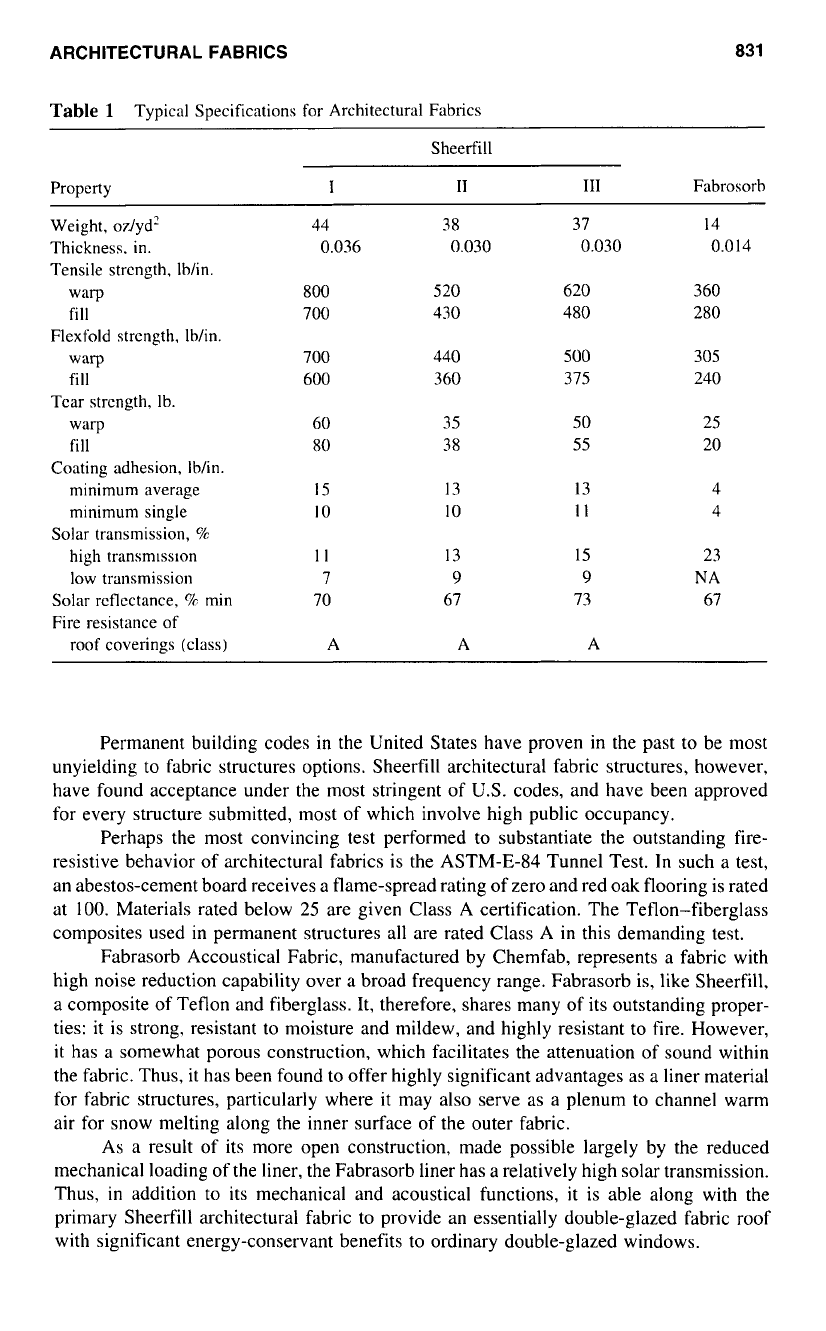
ARCHITECTURAL FABRICS
831
Table
1
Typical Specifications for Architectural Fabrics
Sheerfill
Property
I
11
I11
Fabrosorb
Weight, o7Jyd’
Thickness. in.
Tensile strcngth. Iblin.
warp
fill
Flexfold strength. Win.
warp
fill
Tcar strength, lb.
warp
fill
Coating adhesion, Win.
minimum average
minimum single
Solar transmission,
%
high transmlssmn
low transmission
Solar reflectance,
%
min
Fire resistance
of
roof coverings (class)
44
0.036
38
0.030
37
0.030
14
0.014
800
700
5 20
430
620
480
360
280
700
600
440
360
500
375
305
240
60
80
35
38
50
55
25
20
13
10
13
11
15
10
4
4
II
7
70
13
9
67
15
9
73
23
NA
67
A A
A
Permanent building codes in the United States have proven in the past
to
be most
unyielding to fabric structures options. Sheerfill architectural fabric structures, however,
have found acceptance under the most stringent of U.S. codes, and have been approved
for every structure submitted, most of which involve high public occupancy.
Perhaps the most convincing test performed to substantiate the outstanding fire-
resistive behavior of architectural fabrics is the ASTM-E-84 Tunnel Test. In such
a
test,
an abestos-cement board receives
a
flame-spread rating of zero and red
oak
flooring is rated
at
100.
Materials rated below
25
are given Class A certification. The Teflon-fiberglass
composites used in permanent structures
all
are rated Class A in this demanding test.
Fabrasorb Accoustical Fabric, manufactured by Chemfab, represents
a
fabric with
high noise reduction capability over
a
broad frequency range. Fabrasorb is, like Sheerfill,
a
composite of Teflon and fiberglass. It, therefore, shares many of its outstanding proper-
ties: it is strong, resistant to moisture and mildew, and highly resistant to fire. However,
it
has
a
somewhat porous construction, which facilitates the attenuation of sound within
the fabric. Thus, it has been found
to
offer highly significant advantages
as
a
liner material
for fabric structures, particularly where
it
may
also
serve
as
a
plenum to channel warm
air for snow melting along the inner surface of the outer fabric.
As
a
result of its more open construction, made possible largely by the reduced
mechanical loading of the liner, the Fabrasorb liner has
a
relatively high solar transmission.
Thus,
in
addition
to
its mechanical and acoustical functions,
it
is able along with the
primary Sheerfill architectural fabric to provide an essentially double-glazed fabric roof
with significant energy-conservant benefits to ordinary double-glazed windows.
